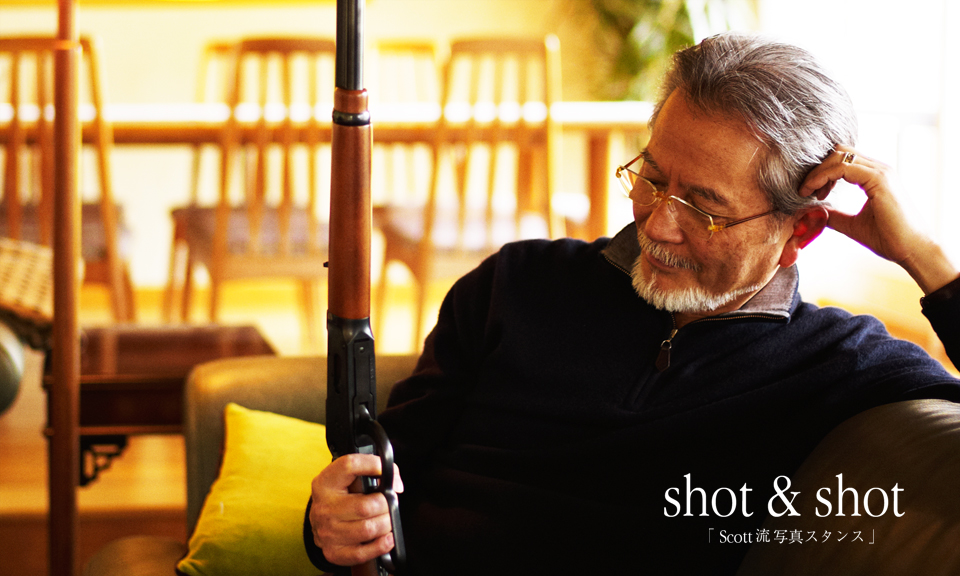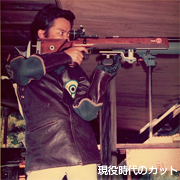
 The title of Mr. Scott's blog is "shot & shot." He's a former rifle shooter with a wonderful record (ranked 2nd in Osaka prefecture, 13th in the nation * National Rifle Association of Japan) and he named his blog because he associates firing the camera's shutter with pulling the rifle's trigger.
The title of Mr. Scott's blog is "shot & shot." He's a former rifle shooter with a wonderful record (ranked 2nd in Osaka prefecture, 13th in the nation * National Rifle Association of Japan) and he named his blog because he associates firing the camera's shutter with pulling the rifle's trigger.
He explains the reasons he associates photo shooting with rifle shooting:
- Rifle shooting: aim the rifle, make sure it's pin-pointing the target, and shoot.
- Photo shooting: quickly frame and fire the shutter.
 He says these two actions are similar in terms of "timing of breathing." I was amazed by the fact that he pulls the trigger between the heartbeats when he shoots a rifle. The average pulse rate of adult men is about 60-70 per minute. I can only guess, but while a shooter keeps pulling the trigger between the heart beats every about 1 second, s/he must be in a state where tension and tranquility coexist. In other words, it's an action of cutting time up into pieces, or of feeling infinite time. Imagine. In a certain period of time in between 1 to 4 hours, a shooter shoots through the center of the target (whose diameter is 1cm for 50m away and 10cm for 300m away) without fail. Only the shooter's heartbeat echoes and there's no other sound. When the heart starts to beat faster, it becomes even faster. In such a tension, the shooter may lose the right timing. And, he says that's not good.
He says these two actions are similar in terms of "timing of breathing." I was amazed by the fact that he pulls the trigger between the heartbeats when he shoots a rifle. The average pulse rate of adult men is about 60-70 per minute. I can only guess, but while a shooter keeps pulling the trigger between the heart beats every about 1 second, s/he must be in a state where tension and tranquility coexist. In other words, it's an action of cutting time up into pieces, or of feeling infinite time. Imagine. In a certain period of time in between 1 to 4 hours, a shooter shoots through the center of the target (whose diameter is 1cm for 50m away and 10cm for 300m away) without fail. Only the shooter's heartbeat echoes and there's no other sound. When the heart starts to beat faster, it becomes even faster. In such a tension, the shooter may lose the right timing. And, he says that's not good.
What about photography? Pulling the trigger and pressing the shutter button can be similar, but is it as nerve-wracking as rifle shooting? It could be close when framing is tight... The topic shifted to music, but it helped me learn why rifle shooting and photo shooting overlap.
Mr. Scott says there's always music in his life. He affirms that life is like music. There's always sound in his head even though it's silent outside. He likes classic music because of the conceptual and musical variety represented by dynamism/delicacy and joy/sorrow that express romance in life. What he wants to express in his photography is this romantic emotion and his model music are the symphony no. 3 by Saint-Saens, the symphony no. 8 by Dvorak, and the symphony no. 2 by Brahms. I'm only familiar with loud electric music with fast flat beats, so it was a little hard for me to follow what he was talking about, but I could imagine a music score. And, somewhat could figure the association between rifle shooting and photo shooting.
Musical notes can be transcribed in order on the score. However, how to connect or disconnect them and how emotionally they can be played depend on each player. And, audience listen to the music, add their own emotion to it, and they say, "I'm touched." So, even though music can be transcribed on the score, it only shows one aspect of music. Now, let's link this discussion to photography.
Let me guess how "shot & shot" is grounded. For example, an elderly couple is walking happily hand in hand. This may be a scene that many people instantly want to photograph. However, how tight do they hold their hands? Is the husband adjusting his step length to his wife? Or, how do their back look? They all depend on the context behind them. So, just like the transcribed notes, the catchy scene shows just one aspect of the whole story. Of course, it's OK to capture the very scene straightforward. But, photography is an action of fixing the moment on the photographic sensitive material. The real scene keeps flowing, so of course we can't include everything on photography. But, that's why, although I contradict, I want to try to capture even the anima between the scenes. By doing so, I may be able to include something in one shot. What's something? It's a sort of wish or prayer. And, I look into the viewfinder. My optic nerve extends to the entire body and I integrate myself into the scene in front of me. Then, "the sound disappears." Now, how will you feel when you look at his shots in the next page?